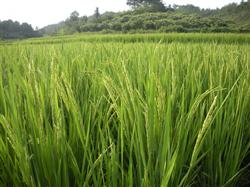How to manage the heading and fruiting stage of rice?

How to manage the heading and fruiting stage of rice? Please introduce the management method of rice heading and fruiting stage, which refers to the period from heading to yellow maturity, which is the key period for determining grain number and grain weight. The goal of field management is to raise root, protect leaves, increase seed setting rate and 1000-grain weight. The main measures of field management are as follows: 1. Scientific irrigation rice heading and flowering stage is the sensitive period of rice to water, and its sensitivity is second only to the late booting stage. As rice heading is in the high temperature season, plant transpiration and evaporation are large, in order to meet the water supply, the shallow water layer should be maintained. Water shortage will affect photosynthesis and carbohydrate transport, but it can not be irrigated in deep water for a long time, otherwise it is not conducive to root growth. Therefore, the method of gap irrigation should be adopted, that is, it should be irrigated once, let it dry naturally for 3-4 days, and wet for 2-3 days to fill with new water again and again until it is ripe. Especially for large panicle varieties, because of their longer filling period, it is not suitable to cut off water prematurely, so as not to affect the yield. After yellow ripening, the physiological water requirement of rice decreases, and it is generally drained and dried about 7 days before harvest in order to harvest in time. 2. Scientific fertilization at full heading stage can increase leaf nitrogen content, improve photosynthetic capacity, prolong leaf function, maintain root activity, and prevent premature senescence. The application of nitrogen fertilizer at full heading stage depends on the soil, climate, seedling condition and fertilizer. Generally, fields with high soil fertility are not applied, fields with low temperature and rainy days are not applied, fields with not yellow seedlings are not applied, fields with serious diseases are not applied. Fertilization at full heading stage is usually sprayed outside the root. 0.5 kg urea plus 0.2 kg potassium dihydrogen phosphate per mu and 60 kg water can be sprayed on the leaves of rice after flowering in the afternoon. High fertility fields, such as garlic fields, can be sprayed with potassium dihydrogen phosphate solution instead of urea. 3. Timely control of diseases, insect pests and rodents at the heading and fruiting stage of rice, there are mainly rice blast (such as rice blast, panicle blast, branch blast), bacterial leaf blight, etc., and insect pests mainly include stem borer (white ear), rice planthopper, etc., these diseases and insect pests are usually found and controlled in the early and middle stages of rice growth, but if the above diseases and insect pests still exist, they should be controlled in time. Minimize the harm of diseases and insect pests. Weeding in mid-tillage mainly adopts the method of manual pulling out all kinds of weeds thoroughly to prevent weed seeds from scattered in the field and increase the difficulty of rice weeding in the coming year. In the prevention and control of rodent damage, the method of artificial anti-rodent "poison bait" is mainly adopted to prevent the yield loss caused by rodent damage. Click to get more rice planting techniques click to get more food crop planting techniques
- Prev

How to administer medicine before and after heading of rice?
How to administer medicine before and after heading of rice? Please give guidance and introduction to whether it is early rice or late rice, before and after heading is generally the occurrence of a variety of diseases and insect pests, the need for chemical pesticide control, but in this growth period, some are very easy to cause drug damage, resulting in unnecessary losses, worthy of attention. ...
- Next

How to manage moisture at heading and fruiting stage of rice?
How to manage moisture at heading and fruiting stage of rice? Please introduce that the middle and last ten days of July is the period when rice enters the period of heading and fruiting. The scientific nature of water management is very important to the yield and yield of rice. First, heading and flowering stage is the period when rice is sensitive to water. Its sensitivity is second only to the late booting stage.
Related
- The first cup of black tea in spring, the flavor and history of tea gardens in Kenya, Africa
- The computer can not only choose potatoes, but also grow tea rice. AI will grow winter oolong tea champion.
- It is not only the inflated tea bitten by insects, but also engraved with the four seasons tea in Beipu.
- The Oriental Beauty Tea Festival in Zhuxian County takes the stage at the weekend to experience the plus-size feast of oil tea.
- & quot; Oriental Beauty Tea & Exploration of Emei in Hsinchu, the hometown of quot;
- The new variety of strawberry "Tainong 1" dessert is the first choice with mellow aroma. Crimson gorgeous
- History of Tea in Taiwan: from Wild Inner Mountain to Export Tea Garden
- Two types of Taiwan Oriental Beauty Black Tea won the British three-Star Award for Childhood Tea Xiang Zhang Jiaqi changed from pilot to champion tea maker.
- Banana species and varieties: the planting history of Taiwan Xianren banana and dwarf banana is long, is banana disease resistant?
- Coffee planting Technology: Qianjie Coffee from Seedling to harvesting

